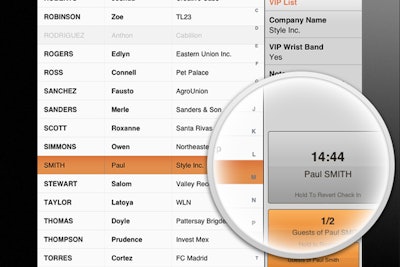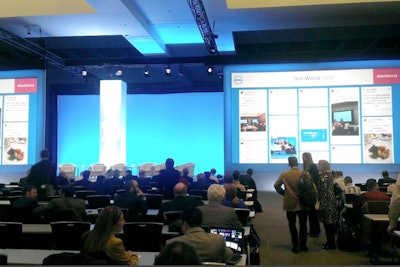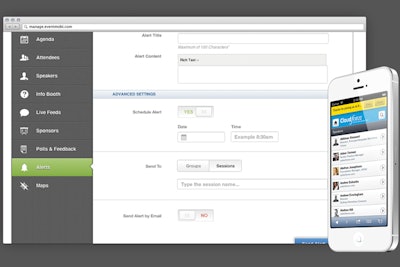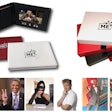1. Zkipster

Zkipster is a service to manage guest check-in on iPads at private events. It launched last year in the United States following a European debut in 2011. Users upload their guest list on a Web platform and then access it at the event through an iPad app; it takes an average time of two seconds to check in a guest at an event with 750 people. Hosts can edit the guest list in real time and send email and text alerts when specific guests arrive. After the event, the system can generate data such as the time that people arrived, which can be helpful when planning staffing for future events. Clients include Hearst, HBO, Hugo Boss, and the Whitney Museum. Future updates will allow each guest to be identified with a photo rather than just a name. Pricing can be done on a per-event basis for $75 or as a subscription for $750 for four months or $2,000 per year.
Photo: Courtesy of Zkipster
2. Blyve

Blyve is a platform for live online events. The system is intended for companies to host interactive online events: for example to launch a new product, share educational information, or conduct training. Walgreens has used Blyve to host an interactive chat on beauty tips, with the link to the chat embedded on the Walgreens Web site. The system has interactive features such as polls and moderated Q&A functions. A Twitter widget allows hosts to search for tweets about the online event and then invite the people who tweeted to join the conversation. The platform can also integrate media from Ustream, YouTube, Instagram, and other services. Hosts can use the platform to generate revenue by including ads or offers from sponsors. Pricing is either per event or, for recurring events, based on the number of participants.
Photo: Courtesy of Blyve
3. Postano

Postano is a tool used to display social media feeds online or at an event. The system aggregates content from Twitter, Facebook, Instagram, YouTube, Tumblr, Pinterest, and more based on specific account names or hashtags. Hosts can monitor the content before it is shared through the system or have it instantly displayed. The Postano display can be designed with custom colors, logos, and animations, and it can be shared through Facebook, a Lightbox widget, on a large screen, or on a touch-screen monitor. At Dell World in December the company used Postano to display a live feed of content from several conference hashtags during remarks from C.E.O. Michael Dell and elsewhere at the event. Additional Postano clients include Tiffany & Company, Microsoft, and Nine West. Pricing starts at $5,000.
Photo: Courtesy of Postano
4. Emobile

Emobile is the newest product in the suite of event management software from Etouches. The tool allows users to design, test, and publish their own Web-based mobile app through a simple drag-and-drop interface. The product is integrated with other software from the company so planners can import data such as agendas and directories of speakers and attendees. In addition, attendees can use the app to communicate with one another. For now, Emobile creates a Web app that can be downloaded by scanning a QR code. In April it will become available as a mobile app for iOS, Android, and other platforms. The product is a $500 add-on to the Etouches software package.
Photo: Courtesy of Etouches
5. EventMobi

When EventMobi launched in 2009 as one of the first do-it-yourself app creators, it was primarily a digital show guide. Since then it has been updated with interactive features. The latest updates, which begin rolling out in February, will give planners the ability to communicate with subsets of attendees—for example, to invite V.I.P.s to a private dinner or send an alert to all exhibitors. EventMobi is also adding a private real-time chat function for attendees so they can use the app to initiate meetings or networking.
Photo: Courtesy of EventMobi



















